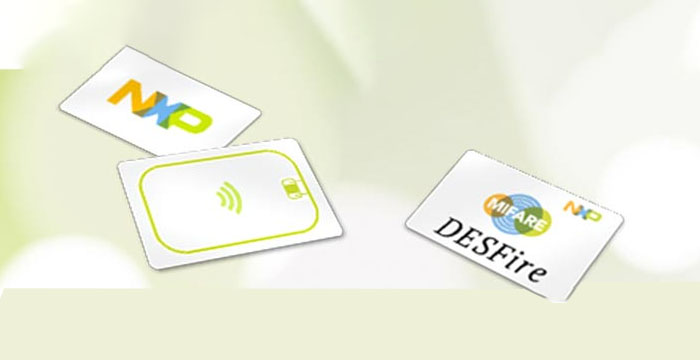RFID MIFARE chips are manufactured by NXP Semiconductors. They comply with ISO/IEC 14443 Type A standards and are used in contactless smartcards. MIFARE chips are embedded in over one billion smart cards and millions of readers worldwide.
There are several different types of MIFARE chips, each with its unique features. This guide helps you with how to choose an RFID MIFARE chip MIFARE S50? S70? Ultralight C? Read on.
What is RFID MIFARE?
RFID MIFARE is NXP Semiconductor’s brand name for a series of chips used in contactless communication. The name MIFARE covers four technology platforms:
The technology was deployed in 1994 and has become the de facto industry standard for contactless smart cards. It is used in a wide variety of applications, including public transport, access control, identity cards, and event ticketing.
What are the Benefits of RFID MIFARE Chips?
MIFARE technology uses AES and DES/Triple-DES encryption for security. This high-grade security is critical for applications where data needs to be protected, such as access control, cashless vending, and public transport. As a result, RFID Classic was an instant success in the contactless ticketing market.
Additionally, the technology guarantees interoperability between smart card operators and allows for secure data storage and fast transaction times. It conforms to international standards (ISO/IEC 14443) and is backed by a wide range of patents.
When using MIFARE technology, only the card, and the reader need to be brought into proximity. No physical contact is necessary, which makes the technology ideal for use in hygiene-sensitive environments.
Overall, you can expect a flawless user experience with RFID MIFARE technology. It is widely accepted, compatible, fast, and secure.
What are the Different Types of MIFARE Chips?
There are four main types of MIFARE chips: Classic, Plus, DESFire, and Ultralight. Each of these chips has its unique features and applications. Here is an in-depth look at each type of MIFARE chip.
- MIFARE Classic
This was the pioneer product in the MIFARE range. It is a 13.56MHz contactless smart card that complies with the ISO/IEC 14443A standard. The chip has 1KB or 4KB of read-write EEPROM memory.
The 1K MIFARE IC has 1KB subdivided into 16 sectors, each of which has 4 blocks. One block is used for the access conditions and contains fixed data. The other three blocks in a sector are user data blocks, which can be read and written as desired.
The 4K MIFARE IC has 4KB of EEPROM memory that is subdivided into 40 sectors. 32 of these are identical to the sectors in the 1K device, but eight of the sectors have 16 blocks, providing 288 bytes per sector instead of just 192.
It is used in public transport, access control, and other applications where speed and convenience are important. The technology is now considered a legacy, but it has been superseded by more modern products such as Mifare Plus and Mifare DESFire.
MIFARE Classic uses a proprietary protocol for communication with the reader. The advantage of this is that it is more difficult to clone cards. However, the protocol has been cracked and it is now possible to create clones using NFC-enabled smartphones.
MIFARE Classic cards are no longer considered secure for high-security applications. To solve this problem, NXP Semiconductors created a new MIFARE Classic variation called MIFARE Classic EV1. This uses stronger encryption and is not vulnerable to the same attacks.
- MIFARE DESFire
MIFARE DESFire is a newer product that was introduced in 2003. It uses the ISO/IEC 14443A standard and is available in 2KB, 4KB, and 8KB versions. The chip has built-in cryptographic security features for authentication and data encryption.
MIFARE DESFire cards are used in a variety of applications such as public transport, access control, event ticketing, and loyalty programs. The cards are widely used because they offer a high level of security and are very versatile.
One advantage of MIFARE DESFire cards is that they can be used with other standards such as ISO/IEC 15693 (NFC). This makes them compatible with a wider range of devices and readers.
MIFARE DESFire cards are more expensive than MIFARE Classic cards, but they offer a higher level of security. You can buy them in four different configurations, including:
- (One) Triple- DES only (with 4KB memory)
- (Three) AES ( With 2KB, 4KB, or 8KB memory)
The AES variants have better security features and are compliant with ISO/IEC 14443-4. Their integrated circuit uses an 8051 processer (with 3DES or/and AES cryptographic accelerator), making them faster than the Classic variants.
The MIFARE DESFire EV1 was introduced in 2008 and is available in 2KB, 4KB, and 8KB versions. It has several improved security features such as mutual authentication and 128-bit AES encryption. The cards are backward compatible with MIFARE DESFire readers.
Later, other variations of MIFARE DESFire were introduced as follows:
- MIFARE DESFire EV2. This has several security improvements such as 3rd-party transaction authentication, proximity checks to prevent relay attacks, and a tamper-detection mechanism. The cards are backward compatible with MIFARE DESFire EV1 readers.
- MIFARE DESFire EV3. This variation is ISO/IEC 14443 A 1–4, NFC Forum Tag Type 4 compliant, and ISO/IEC 7816-4 compliant. It has transaction timer counters and a random ID number generator. The cards are backward compatible with MIFARE DESFire EV2 readers.
Overall, MIFARE DESFire cards are more secure and versatile than MIFARE Classic cards. They are suitable for access control, micropayment, and loyalty programs.
- MIFARE Plus
MIFARE Plus is an evolution of the MIFARE Classic product. It offers Advanced Encryption System (AES) 128-bit security features. The cards are compatible with MIFARE Classic readers but offer a higher level of security.
MIFARE Plus cards are used in a variety of applications such as public transport, access control, event ticketing, and loyalty programs. They offer a high level of security and are very versatile.
There are two variants of this technology, including MIFARE Plus EV1 and MIFARE Plus EV2. These cards have better security features, including ISO 7816-4 wrapping, proximity check, transaction MAC, secure end-2-end channel, and transaction timer.
- MIFARE Ultralight
MIFARE Ultralight offers 512-bits/ 64 bytes of memory and is used in low-cost applications such as public transport, access control, and event ticketing. They do not have cryptographic security features and are inexpensive.
Its memory comes in 16 pages of 4 bytes each. The first page is used for the UID (unique identifier), and the other pages can be used for storing data.
Due to their inexpensive nature, the MIFARE Ultralight chips are used for disposable tickets. For example, they can be used by World Cup organizers for one-time event ticketing.
They have a one-time-programmable bit & write-lock feature. This prevents re-writing of the UID and allows the Ultralight chip to be used as a tamper-proof security seal. They come in two different variations, including:
- MIFARE Ultralight EV1. This type is available in 384 and 1024 bits versions and is used in public transport ticketing, event ticketing, and loyalty cards. It features a 32-bit password system for authentication.
- MIFARE Ultralight C. This technology is used for disposable ticketing in public transport and event management. It uses Triple DES for security, making it hard to clone. It is best for short-term and one-time use applications. It is versatile and can be used in many applications, including ticketing, access control, and loyalty programs.
How to choose an RFID MIFARE chip? MIFARE S50? S70? Ultralight C?
Now that you know the different MIFARE chips, it’s time to learn how to choose the right one for your application. Here are some of the factors that will influence your choice:
- Security. You must decide your ideal security features before you step out to shop for MIFARE S50, S70, or Ultralight C. For example, if you need a high level of security, you should choose a MIFARE Plus or DESFire chip. These two technologies use AES 128-bit encryption and are very secure.
- Memory. MIFARE Plus and DESFire chips have more memory (up to 8KB) than MIFARE Classic and Ultralight chips. If you need a lot of memory, you should choose one of these two technologies.
- Versatility. You must decide how versatile you need the chip to be. MIFARE Plus and DESFire chips are more versatile than MIFARE Classic and Ultralight chips. They can be used in many applications, including access control, micropayment, and loyalty programs. Ultralight chips are only ideal for one-time ticketing or other low-security applications.
- Cost. How much you’re willing to spend? MIFARE Plus and DESFire chips are more expensive than MIFARE Classic and Ultralight chips. If you’re on a budget, you should choose one of the latter two technologies.
- Applications. If you need a chip for public transport ticketing, you should choose MIFARE Ultralight. If you need a chip for payment, you should choose MIFARE Plus or DESFire.
Overall, you must decide the security, memory, versatility, cost, and applications before you can choose the right MIFARE chip for your application. Each type of chip has its advantages and disadvantages as detailed herein. You must decide which one is best for your application.
Related Articles
- A Beginner’s Guide – What Is An NFC Tag?
- How To Buy RFID Tags – An All-Inclusive RFID Tag Buying Guide
- Learn All About Different Types Of RFID Tags
- Unique Features And Benefits Of Custom RFID Tags
- The Beginner’s Guide To RFID
- What Are RFID Chips?
- How To Choose LF EM Series RFID Chip? EM4100? EM4200? OR EM4305?
- What’s The Difference Between Ntag213, Ntag215, And Ntag216?


